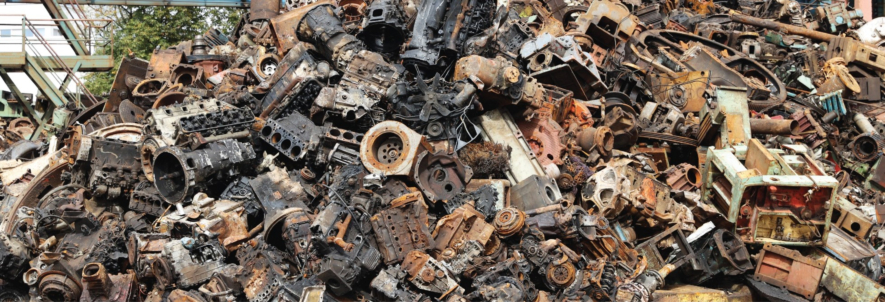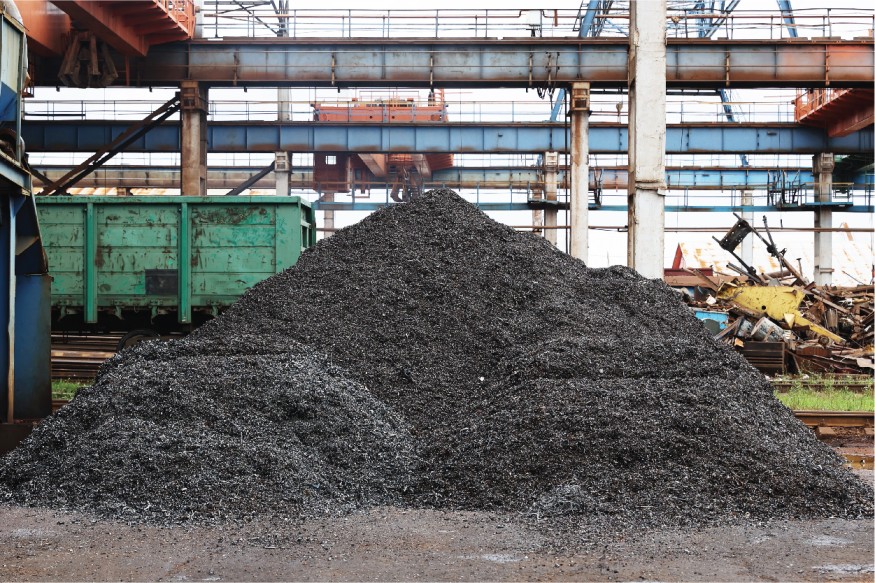
Understanding Scrap Metal Rules and Regulations to Enhance Worker Safety
Scrap metal has considerable economic value throughout the world. But it's also considered hazardous waste and poses many potential health hazards to workers who handle it, produce it, transport it, or dispose of it. For this reason, anyone working within an occupational environment where scrap metal may be present must be aware of basic scrap metal safety considerations. These include the potential health effects of scrap metal exposure, the type of personal protective equipment (PPE) required to protect workers, and best practices for mitigating health risks, including OSHA 3348and other scrap metal rules and regulations.
What Industries Use or Produce Scrap Metal?
Scrap metal includes a diverse range of waste metals and metallic materials and products. These scrap metals are typically capable of being recycled following prior use in manufacturing.According to the Occupational Health and Safety Administration (OSHA), the U.S. metal scrap recycling industry processes the following amounts of metal every year:
- 56 million tons of scrap iron and steel
- 1.5 million tons of scrap copper
- 2.5 million tons of scrap aluminum
- 1.3 million tons of scrap lead
- 300,000 tons of scrap zinc
- 800,000 tons of scrap stainless steel
These materials tend to hold monetary value and can be reused for future products or manufacturing processes. Among the chief players of scrap metal recycling (also called secondary metal processing)are metal stamping service providers. Metal stamping service providers use a range of techniques to convert flat metal into a variety of shapes and forms. These reformed metal structures can then be used in a range of industries—aerospace, medical, automotive, agricultural, construction, and more.

What is Scrap Metal Commonly Used For?
As suggested, the primary appeal of scrap metal is that it can be recycled and reused, which has beneficial economic and environmental implications, proponents say. Scrap metal may find its way into common everyday products and materials, including:
- Roads and bridges
- Buildings and other structures
- Automobile parts
- Containers, including beverage cans
- Appliances, tools, and other home furnishings
When used correctly, scrap metal may help companies save on overhead costs and reduce their environmental impact. However, special care must be taken to ensure solid scrap metal safety procedures and policies are maintained, given that these materials can pose potential hazards—both acute and long-term—to human health.
Safety Considerations When Working with Scrap Metal
Scrap metal rules and regulations exist to protect the people who handle these materials. Procedures used to process and handle scrap metal—including gas torch cutting and heating, blanking, punching, piercing, bending, bailing, compacting, shredding, melting, and loading/unloading—can expose workers to risk of serious harm or even death if proper safety steps are not implemented.
Two key areas of risk for a scrap metalworker include exposure to toxic materials and physical injury.
Toxic or Dangerous Materials Associated with Scrap Metal Handling
Scrap metal often contains heavy metals and other toxic materials that can easily be released into the air or emit harmful fumes. Excessive or cumulative exposure to these chemicals can have acute and chronic effects on health.
Handling or producing scrap metal may expose workers to a wide range of hazardous materials known to have both short- and long-term health effects. According to OSHA's comprehensive guide known as Guidance for the Identification and Control of Safety and Health Hazards in Metal Scrap Recycling, or OSHA 3348, these chemicals include:
- Cadmium: short-term exposure to this heavy metal (a known human carcinogen) is linked to weakness, fever, headache, chills, sweating and muscle pain; long-term effects include an increased risk of lung or prostate cancer, kidney damage, hypertension, emphysema, bone disease, anemia, teeth discoloration, and loss of smell
- Beryllium: inhaling this metal is associated with a lung condition known as chronic beryllium disease (CBD)
- Lead: according to OSHA, overexposure to lead is one of the most common types of overexposure within the scrap metal industry; the heavy metal is known to damage the kidneys, brain, reproductive systems, digestive system, and cardiovascular system, and early signs of lead poisoning can include fatigue, headache, decreased appetite, and a metallic taste in the mouth
- Mercury: high levels of exposure to mercury can lead to permanent damage to thebrain, kidneys, and developing fetus, and may cause temporarylung damage, nausea, vomiting, skin and eye irritation,diarrhea, and blood pressure and heart rate changes following acute exposure to mercury vapors
- Arsenic: while the U.S. has not produced arsenic since the mid-1980s, arsenic is still imported for domestic use from places like China and Japan; arsenic is a known human carcinogen and can increase the risk of lung cancer, as well as short-term lung and skin irritation
Other materials found in various scrap metalthat may pose varying degrees ofhealth hazardsinclude cobalt, antimony,manganese, nickel, selenium, tin, zinc, vanadium, and radioactive scrap.
Common Injuries Associated with Scrap Metal Handling
OSHA has the grim task of researching and sharing case studies of occupational industries involved in scrap metal recycling. These injuries can range from minor to severeor even fatal and may arise within any number of tasks required of the scrap metalworker.
Injuries may include:
- Musculoskeletal pain due to poor posture, frequent heavy lifting, and operating heavy machinery
- Cuts, bruises, fractures, and burns
- Eye, throat, andlung irritation
- Foreign object impalement
- Traumatic brain injuries
- Crush injuries
- Limb loss and traumatic amputation
- Slips and falls
- Motor vehicle accidents
Practices and Measures To Decrease Safety Risks When Working With Scrap Metal
OSHA outlines a number of safety measures employers can implement to keep workers safe. Chief among these is the use of personal protective equipment (PPE).
Appropriate foot, eye, and head protection is imperative for scrap metal handling. OSHA recommends a range of PPE options including respirators, thick clothing, gloves, sturdy boots, and hard hats. To protect employee clothing and skin from chemicals and heat, as well as to prevent cross-contamination, disposable PPE, including coveralls, gowns, sleeve covers, and shoe covers can provide a cost-effective and safety-minded solution.
Of course, thespecific type of PPE required by a worker should take into consideration several factors, including:
- The type of scrap metal being handled
- The type of occupational activity being performed (e.g., gas torch heating, loading,constructing, etc.), which can influence if and how hazardous materials are emitted into the air (via fumes, dust,projectiles, etc.)
- The type of equipment and machinery used
- The physical environment in which the occupational activity is being performed (e.g., inside versus outside)
Providing high-quality PPE is only part of the injury mitigation process for workers. Employers must also ensure that employees are well-trained in proper donning and doffing techniques and that they understand how to properly care for PPE to reduce damage or cross-contamination. If any damage to PPE is observed, such as tears or rips, employees should notify their supervisors immediately; having backup PPE on hand is a good way to minimize the risk of downtime and decreased productivity.
In addition to proper PPE, an organization's scrap metal safety plan should include the following features:
- Ensure all workers are informed of the hazardous chemicals found in scrap metal they are handling,and what their known or suspected impacts are on short-term and long-term health
- Train employees on proper handling of equipment, including the use of seatbelts where relevant
- Keep emergency stop devices within reach of operators at all times
- Educate employees about proper body mechanics and lifting techniques
- Ensure employees are aware of how to reduce unnecessary physical stress and strain and maintain environmental awareness
- Encourage a degree of self-awareness among employees, so they understand what they are capable of performing on their own
- Encourage workers to report possible hazards such as equipment failure or damage
- Ensure all scrap metal is received from reliable sources
- Obtain and make available all safety data sheets
- Establish and maintain routine safety inspections and other procedures to assess for and reduce the risk of injury (these tasks should be delegated or assigned to specific employees to ensure appropriate follow-through)
Conclusion
The scrap metal industry in the United States processes several million tons of steel, iron, and other types of metals every year. While this industry offers appealing benefits in terms of resource preservation, environmental impact, and operating costs, scrap metals do pose potential health hazards to workers who are handling and transporting these materials.
To mitigate the numerous and potentially serious risks of injury or illness, employers must ensure proper scrap metal safety procedures are regularly reviewed and maintained within their daily operations. Companies working within the scrap metal industry should refer to and abide by OSHA 3348—OSHA's comprehensive guide on scrap metal rules and regulations. The focus should be given to raising awareness about the types of materials found in scrap metal, what types of injuries can happen when handling scrap, and what strategies, including PPE, are effective for improving worker safety.